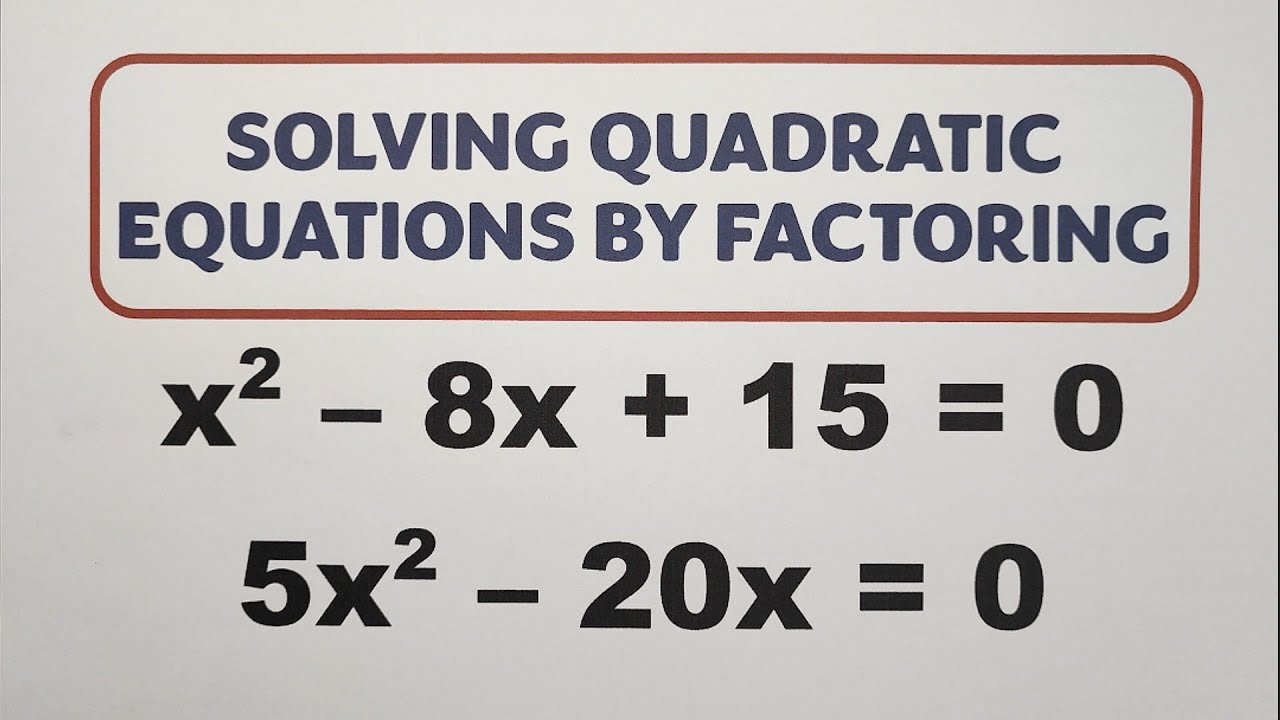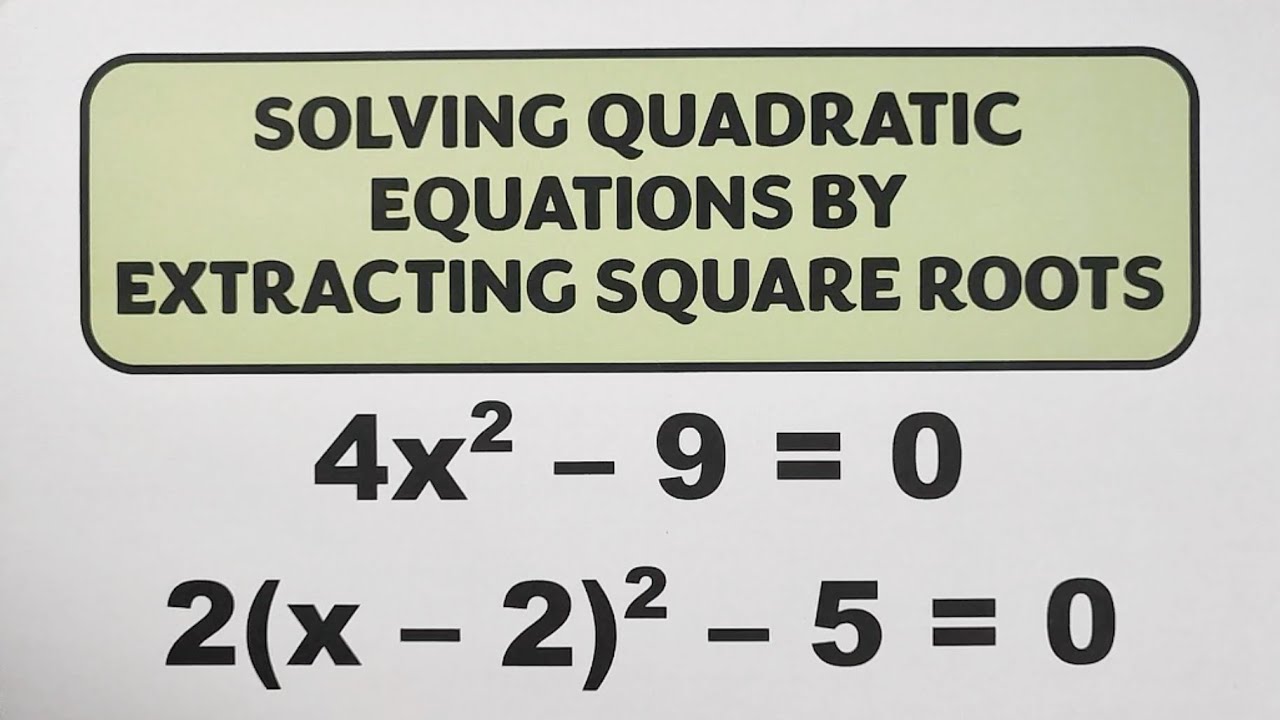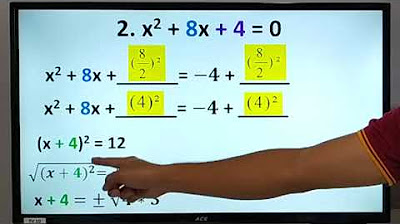How To Solve Quadratic Equations By Factoring - Quick & Simple! | Algebra Online Course
Summary
TLDRThis lesson teaches the method of solving quadratic equations by factoring, including the use of the difference of perfect squares technique and factoring by grouping. Examples provided illustrate how to factor and solve equations like x^2 - 49 = 0, 3x^2 - 75 = 0, and 9x^2 - 64 = 0, as well as trinomials such as x^2 - 2x - 15 and x^2 + 3x - 28. The script also covers solving quadratics when the leading coefficient is not one, and concludes with using the quadratic formula as an alternative method, demonstrating its application with examples.
Takeaways
- 📚 The lesson focuses on solving quadratic equations by factoring and introduces the difference of perfect squares technique.
- 🔍 The square root of the squared terms is used to factor equations like x^2 - 49 = 0 into (x + 7)(x - 7).
- 📝 Setting each factor equal to zero is a method to find the values of x, as demonstrated with x + 7 = 0 and x - 7 = 0.
- 🤔 For equations not easily factored by perfect squares, the greatest common factor (GCF) can be extracted, as shown with 3x^2 - 75 = 0.
- 💡 The difference of perfect squares technique is applied to factor x^2 - 25 into (x + 5)(x - 5) after simplifying.
- 🔢 The roots of the equation are found by setting each factor to zero, resulting in x = -5 and x = 5.
- 📉 For equations like 9x^2 - 64 = 0, the difference of perfect squares is applied after taking the square root of the coefficients.
- 📌 The roots are found by setting 3x + 8 = 0 and 3x - 8 = 0, leading to x = -8/3 and x = 8/3.
- 🔑 Factoring a trinomial with a leading coefficient of one involves finding two numbers that multiply to the constant term and add to the linear coefficient.
- 📐 For trinomials with a leading coefficient other than one, the quadratic equation is first multiplied by a factor to make the leading coefficient one, then factored.
- 📈 The quadratic formula (x = -b ± √(b^2 - 4ac) / 2a) is an alternative method to solve quadratic equations when factoring is not straightforward.
Q & A
What is the first example of a quadratic equation discussed in the script?
-The first example is the equation x squared minus 49 equals zero, which is solved using the difference of perfect squares technique.
How is the equation x squared minus 49 solved using the difference of perfect squares?
-The equation is factored into (x + 7) and (x - 7), then each factor is set equal to zero to find the values of x, which are -7 and 7.
What technique is used to solve the equation 3x squared minus 75 equals zero?
-The greatest common factor (GCF) of 3 is factored out, and then the difference of perfect squares technique is used to solve the resulting equation x squared minus 25.
What are the values of x for the equation 3x squared minus 75 equals zero?
-The values of x are -5 and 5, found by setting each factor (x + 5 and x - 5) equal to zero.
How is the equation 9x squared minus 64 solved?
-The difference of perfect squares technique is used, factoring the equation into (3x + 8) and (3x - 8), and then solving for x.
What are the values of x for the equation 9x squared minus 64 equals zero?
-The values of x are -8/3 and 8/3, found by setting each factor equal to zero and solving the resulting equations.
How do you factor the trinomial x squared minus 2x minus 15?
-The trinomial is factored into (x - 5) and (x + 3) by finding two numbers that multiply to -15 and add up to -2.
What are the values of x for the trinomial x squared minus 2x minus 15?
-The values of x are 5 and -3, found by setting each factor equal to zero.
What is the process for factoring a trinomial when the leading coefficient is not one?
-You first find two numbers that multiply to the product of the leading coefficient and the constant term and add up to the coefficient of the linear term. Then you replace the linear term with the sum of these two numbers and factor by grouping.
How is the quadratic formula expressed?
-The quadratic formula is x = (-b ± √(b² - 4ac)) / (2a), where a, b, and c are coefficients from the quadratic equation in standard form.
How are the solutions for the quadratic equation 8x squared plus 2x minus 15 found using the quadratic formula?
-By substituting a = 8, b = 2, and c = -15 into the quadratic formula and solving for x, the solutions are found to be 5/4 and -3/2.
Outlines

Cette section est réservée aux utilisateurs payants. Améliorez votre compte pour accéder à cette section.
Améliorer maintenantMindmap

Cette section est réservée aux utilisateurs payants. Améliorez votre compte pour accéder à cette section.
Améliorer maintenantKeywords

Cette section est réservée aux utilisateurs payants. Améliorez votre compte pour accéder à cette section.
Améliorer maintenantHighlights

Cette section est réservée aux utilisateurs payants. Améliorez votre compte pour accéder à cette section.
Améliorer maintenantTranscripts

Cette section est réservée aux utilisateurs payants. Améliorez votre compte pour accéder à cette section.
Améliorer maintenantVoir Plus de Vidéos Connexes

Penting dan Wajib Bisa - Cara Memfaktorkan Bentuk Kuadrat

Solving Quadratic Equations by Factoring @MathTeacherGon - Grade 9 Math

Solving Quadratic Equations by Extracting the Square Roots by @MathTeacherGon

Math8 1G LV4 - Completing the Square and Quadratic Formula

Trinomials (M2 2.3 Lesson)

FACTORING DIFFERENCE OF TWO SQUARES || GRADE 8 MATHEMATICS Q1
5.0 / 5 (0 votes)
